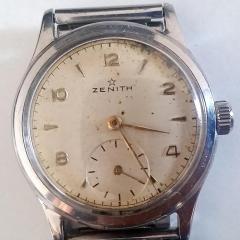Help with regulating mechanical Tissot
-
Recently Browsing
- No registered users viewing this page.
-
Topics
-
Posts
-
just one little minor reminder here this isn't your normal balance wheel. pages 17 and 18 are what you really want to be looking at. normally studs don't turn but this watch has the etachron system designed for lots of adjustment. Personally I would try to rotate the stud back to where it's supposed to be. If you're lucky you didn't actually bend it at the stud it just looks really bad as the stud has been rotated grossly out of position.. I think things will look a lot better if you put the hairspring back where it's supposed to be by rotating the stud. it's hard to tell if you actually did bend it at the stud or not we won't know until you rotate the stud back more or less where it's supposed to be. Then you want to pay attention to the manual of how to put the hairspring back in the regulator pins because yes they rotate also and they rotated specific directions otherwise bad things will happen to your hairspring. so initially you can open up the regulator as wide as it can go and don't worry about closing it until thing everything is right then you can close them a little bit
-
I need to see photos of the whole movement before I comment.
-
Hi @Jon, so, from one extreme to another the beat error is 0.1(min.pos) to 0.2(msx.pos), and as you mentioned the rate does up and down dramatically. Also checked the position of the collet, and the collet is not central to the jewel on the balance cock. Balance moves freely, per my understanding. So, after 24h the ampl. fell down by approx 20 deg, which I would assume is expected. After adjusting the endshake I believe I gained around +10 deg. of balance movement. Which is great, and overall the balance is not at 220'ish deg. What I did next, some might think is non-orthodox, but was wort a try. I too the mainspring out, checked again for endshake and if the pin moves freely, and cleaned everything. Usually when installing the mainspring I would use some barrel grease on the barrel walls, install the spring and put a 2-3 drops of D-5 oil on top of the wounded spring and in the places where the arbor sits. This time I took the spring and applied a ultra this coat of Molykote Dx paste on the whole spring, before installing it in to the barrel, and added some oil to the arbor as usual. The result improved, at a full wound the balance produces about 230-237 deg. @JohnR725 I'm getting closer to 300 😃 What I am noticing, there is a fluctuation in amplitude. With time it would rise and drop about total 8-10 deg in an interval about 2 minutes. I assumed this ruled out the power transfer from the barrel itself. So I took the gear train out, cleaned and lubed.
-
By Hawaiikook808 · Posted
Thank you so much, Hector and CJ. I appreciate the tech sheet and the video. Gasp, I think I will make the attempt. What's the worst that can happen? I think there may be a new balance complete in my future, though. I'll update the post and let you know the result. R, Frank -
So here is the new base (v 2.1), I made it so that the base will fit over and swallow the stump of the hand pusher tool (or at least my clone of the tool), I also reduced the OD of the bottom skirt a little as it looked/felt a little large, here are a few pictures and the fake .pdf file which you need to convert to .zip once downloaded. The cut-out seen on the below image on the bottom of the base should swallow the OD (40 mm, +0.1 mm tolerance) of the stump and the height of the stump 9.5mm (measured to 9.1mm, but rounded to 9.5mm) - let me know if this works for your tool. Note, I think you may need to print supports for the new internal shelf created? Here is the fake .pdf for just the FreeCAD base file and 3mf files Modular Movement Holder.pdf Here is the fake pdf for complete set of the new base and ring FreeCAD/3mf files: Modular Movement Holder base and ring v 2.1.pdf However, I'm wondering how often you could use this feature, adding the dial usually increases the OD of the movement, so you would need a new (larger) adapter ring tuned to the OD of the dial and I wouldn't like to grip the dial in any kind of movement holder if It could be avoided for fear of damaging it. Maybe I'm misunderstanding you?
-








Recommended Posts